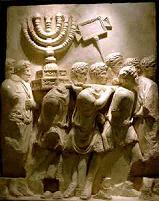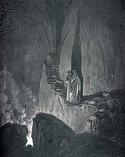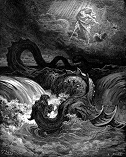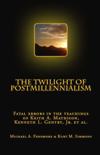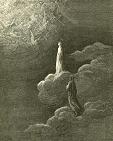The Man of Sin
Kurt Simmons
Futurists have long believed that II Thessalonians “man of sin”
is an arch-evil world leader who will appear before the world’s
end. Preterists maintain that this individual appeared
once for all on the world scene centuries ago. In this
article we want to solve the riddle of the “man of sin” and the
events described by
“Now we beseech you, brethren, by the coming of our Lord Jesus Christ,
and by our gathering together unto him, that ye be not soon
shaken in mind, or be troubled, neither by spirit, nor by word,
nor by letter as from us, as that the day of Christ is at hand.
Let no man deceive you by any means: for that day shall not
come, except there come a falling away first, and that man of
sin be revealed, the son of perdition; who opposeth and exalteth
himself above all that is called God, or that is worshipped; so
that he as God sitteth in the temple of God, shewing himself
that he is God. Remember ye not, that, when I was yet with
you, I told you these things? And now ye know what
withholdeth that he might be revealed in his time. For the
mystery of iniquity doth already work: only he who now letteth
will let, until he be taken out of the way. And then shall
that Wicked be revealed, whom the Lord shall consume with the
spirit of his mouth, and shall destroy with the brightness of
his coming: Even him, whose coming is after the working of Satan
with all power and signs and lying wonders. And with all
deceivableness of unrighteousness in them that perish; because
they received not the love of the truth, that they might be
saved. And for this cause God shall send them strong
delusion, that they should believe a lie: that they all might be
damned who believed not the truth, but had pleasure in
unrighteousness” (II Thess. 2:1-12).
Four issues rise from this passage: 1) What is the
“falling away;” 2) who is the “man of sin;” 3) who and/or what
restrained him; and 4) who would be destroyed? Examination
of these will show that
The Objects of Christ’s Wrath
The first thing we should note is that the coming of Christ and
day of the Lord would result in the destruction of those who
“received not a love of the truth.” Thus, the coming of Christ
in wrath was in wrath upon a specific people. This is an
unmistakable reference to the Jews.
In his first epistle, Paul mentions that the Thessalonians had
“received the word in much affliction” (I Thess. 1:6). He
says that they had “become followers of the churches of God
which in Judea are in Christ Jesus: for ye also have suffered
like things of your own countrymen, even as they have of the
Jews: who both killed the Lord Jesus, and their own prophets,
and have persecuted us; and they please not God, and are
contrary to all men: forbidding us to speak to the Gentiles that
they might be saved, to fill up their sins always: for the wrath
is come upon them to the uttermost” (I Thess. 2:14-16).
Here is specific reference to the wrath that was to come upon
the Jews for crucifying the Lord and persecuting the church.
This is the same wrath described in Paul’s second epistle.
Although Paul indicates the Thessalonians had suffered from
their own countrymen, it is clear the Jews were ultimately
responsible.
In Acts, we learn that the Jews of Thessalonica set the whole
city in an uproar, assaulted the house of Jason, and brought him
and others forcibly before the city rulers (Acts 17:1-9). The
brethren then sent Paul and Silas by night unto Berea, but the
Jews of Thessalonica were so strident in their opposition to the
gospel that they followed Paul there and stirred up the people
of Berea also (Acts 17:10-13). Paul was thus forced to
depart to Athens, and it is from there that he wrote his
epistles to the Thessalonians by the hand of Timothy. It
is in this context that Paul thus writes “it is a righteous
thing with God to recompense tribulation to them that trouble
you; and to you who are troubled rest with us, when the Lord
Jesus shall be revealed from heaven with his mighty angels,
taking vengeance on them that know not God, and that obey not
the gospel of our Lord Jesus Christ” (II Thess. 1:6-8).
The gospels also make abundantly clear that the day of the Lord
would come upon the Jews (Matt. 3:11, 12; 8:12; 10:23; 16:27,
28; 21:33-46; 22:7; 23:34-39; 24; Mk. 13; 14:62; Lk. 19:41-44;
20:16; 21; etc.). Luke sums it up well when he
says, “For there shall be great distress in the land, and wrath
upon this people” (Lk.
He Who Lets
The time for fulfillment of these things was definitely fixed by
the Lord, saying, “This generation shall not pass away, till all
be fulfilled” (Lk.
“And after many plagues completed in the world, in the end he says that
a beast ascended from the abyss…that is, of the Romans.
Moreover that he was in the kingdom of the Romans, and
that he was among the Caesars. The Apostle Paul
also bears witness, for he says to the Thessalonians: Let him
who now restraineth restrain, until he be taken out of the way;
and then shall appear the Wicked One, even he whose
coming is after the working of Satan, with signs an lying
wonders.’ And that they might know that he should come
who then was the prince, he adds: ‘He already endeavours
after the secret of mischief’ – that is, the mischief which he
is about to do he strives to do secretly; but he is not raised
up by his own power, nor by that of his father, but by command
of God.”[2]
Victorinus here connects the “beast” from the abyss with the
“Some think that these words refer to the
The late Canon of Westminster, F.W. Farrar, wrote:
“
J. Stuart Russell, in his classic work on the Parousia of
Christ, states
“At that time Nero was not yet ‘manifested;’ his true character was not
discovered; he had not yet succeeded to the Empire.
Claudius, his step-father, lived, and stood in the way of the
son of Agrippina. But that hindrance was soon removed.
In less than a year, probably, after this epistle was received
by the Thessalonians, Claudius was ‘taken out of the way,’ a
victim to the deadly practice of the infamous Agrippina; her son
also, according to Suetonius, being accessory to the deed.”[5]
Kenneth L. Gentry Jr. is among modern writers reaching the same
conclusion:
Apparently something is presently (ca. A.D. 52) ‘restraining’ the Man
of Lawlessness: ‘you know what is restrining [katechon;
present participle], that he may be revealed in his own time’
(2:6). This strongly suggests the preterist understanding
of the whole passage. The Thessalonians themselves know
what is presently restraining the Man of Lawlessness; in
fact the Man of Lawlessness is alive and waiting to be
‘revealed.’ This implies that for the time-being
Christians can expect some protection from the Roman government.
The Roman laws regarding religio licita are currently in
Christianity’s favor, whole considered a sect of Judaism and
before the malevolent Nero ascends the throne.[6]
A final consideration worth noting is that the Greek “ha
katechon” (“he who lets”) may be rendered in Latin
“qui claudit.” The similarity of claudit and
Claudius has led many to conclude that Paul cryptically
referred to Claudius Caesar by this allusion in a manner similar
to St. John’s reference to Nero by the number six hundred
threescore and six.[7]
Beginning with Tiberius, the Jews were under intense imperial
disfavor, which continued through the reigns of Caligula and
Claudius. Claudius restrained the Jews from persecuting
the church, extending it the protection of law under the
religio licita, even banishing the Jews from
Man of Sin
Tradition among primitive Christians identified
"For the mystery of lawlessness doth already work." He speaks
here of Nero... But he did not also wish to point him out
plainly: and this not from cowardice, but instructing us not to
bring upon ourselves unnecessary enmities, when there is nothing
to call for it.”[10]
Lactantius (A.D. 260-330) writes:
“And while Nero reigned, the Apostle Peter came to
Reference to Nero as a “noxious, wild beast” is generally
understood to be an allusion to the beast of Revelation;
reference to Nero’s attempt to raze the
“In the meanwhile Nero, now hateful even to himself from a
consciousness of his crimes, disappears from among men, leaving
it uncertain whether or not he had laid violent hands upon
himself: certainly his body was never found. It was accordingly
believed that, even if he did put an end to himself with a
sword, his wound was cured, and his life preserved, according to
that which was written regarding him,-"And his mortal wound
was healed," -to be sent forth again near the end of the
world, in order that he may practice the mystery of
iniquity.”[12]
Although Sulpicius Severus erroneously concludes that Nero’s
life was somehow wondrously preserved and would appear again at
the world’s end, he correctly identified Nero with the “beast”
and “man of sin” (cf. Rev. 13:3; II Thess. 2:7).
Other evidence that Nero was the “man of sin” will be discussed
below.
The Falling Away
During the Reformation, many believed that the “man of sin” was
the pope and the “falling away” spoke to Catholicism’s corrupt
forms of worship and doctrine. However, few scholars can
be found who take this seriously today. The present tense
of the verbs indicates that the “mystery of iniquity” was
already at work, and he who “now letteth” would let
until taken out of the way (II Thess. 2:6, 7). This can
hardly describe the papacy, which did not grow up until
centuries later. Instead, the better view is that Paul is
describing the full and final rejection of Christ by the Jews
through their participation in the persecution under Nero and
apostasy from the church and a return to Judaism.
This is the crux of Daniel’s prophecy of the seventy prophetic
weeks (viz., 490 yrs) which would end in the destruction
of the city and temple (Dan. 9:24-27).[13]
It was also spelled out at length by the prophet Isaiah.
First, Isaiah describes God’s anger and contempt for the Jews’
idolatrous devotion to the temple:
“Thus saith the Lord, The heaven is my throne, and the earth is my
footstool: where is the house that ye build unto me? And where
is the place of my rest? For all those things hath mine
hand made, and all those things have been, saith the Lord: but
to this man will I look, even to him that is poor and of a
contrite spirit, and trembleth at my word (Isa. 66: 1, 2).
Then, he shows his abhorrence for the continuing temple cultus,
which stood in denial of Christ’s substitutionary death and
atoning sacrifice:
“He that killeth an ox is as if he slew a man; he that sacrificeth a
lamb, as if he cut off a dog’s neck; he that offereth an
oblation, as if he offered swine’s blood; he that burneth
incense, as if he blessed an idol. Yea, they have chosen
their own ways, and their soul delighteth in their abominations.
I also will choose their delusions, and will bring their fears
upon them; because when I called, none did answer; when I spake,
they did not hear: but they did evil before mine eyes, and chose
that in which I delighted not (Isa. 66:3, 4).
Next, Isaiah speaks to the persecution of Christians by
unbelieving Jews and the promise of Christ’s coming:
“Hear the word of the Lord, ye that tremble at his word; Your brethren
that hated you, that cast you out for my name’s sake, said, Let
the Lord be glorified: but he shall appear to your joy, and they
shall be ashamed (Isa. 66: 5).
And finally, Christ’s coming in wrath to destroy the city and
nation:
“A voice of noise from the city, a voice from the temple, as voice of
the Lord that rendereth recompence to his enemies…For, behold,
the Lord will come with fire, and with his chariots like a
whirlwind, to render his anger with fury, and his rebuke with
flames of fire” (Isa. 66: 5, 15).
Here is explicit reference to the coming of the Lord to destroy
his enemies in the events culminating in the destruction of
Jerusalem in A.D. 70, predictions repeated by Christ in his
Olivet discourse (Matt. 24, 25; Mk. 13; Lk. 21).[14]
This would come, as suggested by the Hebrew writer, after
forty-years, like their fathers’ in the wilderness (Heb.
3:7-4:11; cf. Num. 14:34). The church’s persecution
and apostasy from the faith by a return to the temple cultus is
the dominate theme of the epistle to the Hebrews and attests to
the fact the apostasy Paul spoke of was then underway. The
writer is at pains to demonstrate the provisional nature of the
temple service and Christ’s imminent return to put his enemies
beneath is feet by destruction of the city and nation, warning
his readers from apostasy by returning to Judaism:
“For if we sin willfully after that we have received the knowledge of
the truth, there remaineth no more sacrifice for sin, but a
certain fearful looking for of judgment and fiery indignation,
which shall devour the adversaries…For yet a little while, and
he that shall come will come and will not tarry. Now the
just shall live by faith: but if any man draw back, my soul
shall have no pleasure in him. But we are not of them who
draw back unto perdition; but of them that believe to the saving
of the soul (Heb.
Conclusion
[1]
Tertullian, Concerning the Resurrection of the Flesh,
XXIV; cf. Apology, XXXII.
[2]
Victorinus, Commentary on the Apocalypse, ad 11:7;
Ante-Nicene Fathers, p. 354; emphasis added.
[3]
Augustine, City of
God, XX, xix; cf., Irenaeus, Against
Heresies, V, xxv-xxviii; Lactanius, Divine Inst.
VII, xxv; emphasis added
[4]
F.W. Farrar, The Early
Days of Christianity (1891, Columbian Publishing Co,
NY), p. 13; cf. The Life and Work of
[5]
J. Stuart Russell, The
Parousia (1887,
[6]
Kenneth L. Gentry Jr,
Perilous Times (1999, CMP), p. 104-106 (emphasis in original).
[7]
F.W. Farrar, The Life and Work of St.
Paul, Excursus XIX, (1879, Cassell and Co. ed), p.
727; Darkness and Dawn (1891), pp 73, 74;
.Kenneth L. Gentry Jr, Perilous Times (1999,
CMP), p. 104-106.
[8]
Suetonius, Lives of the
Caesars, Claudius, XXV, 4. Cf. Acts
18:2.
[9]The correspondence between
II Thess. 2:1-12 and Rev. 20:1-11 suggests that the
binding of the dragon in Rev. 20:1-11 refers to
Claudius’ reign and the loosing of the dragon to the
persecution under Nero; the reign of the martyrs answers
to those that had fallen asleep in I Thess. 4:13-18.
See Kurt M. Simmons, The Consummation of the Ages
(2003, Bimillennial Preterist Assoc.), pp. 362-388.
[10]
St. John Chrysostom,
Homilies on II Thess., Nicene-Post Nicene Fathers,
Vol. XXIII; emphasis added.
[11]
Lactantius, Of the
Manner in which the Persecutors Died, Chpt. II;
Ante-Nicene Fathers, Vol. VII, p. 302; cf.
Divine Institutes, VII, xvii; emphasis added.
[12]
Sulpicius Severus, Sacred History, II,
xxviii-xxix; emphasis added.
[13]
"And when did this happen? When were prophecies
completely done away with?...Daniel makes it clear that
he is not talking about the destruction of the temple
under Antiochus but the subsequent destruction under
Pompey, Vespasian, and Titus."
[14]
St. Stephen quoted Isaiah in this place (Acts 7:49)
when accused of teaching that Jesus would come and
destroy the temple (Acts 6:13, 14), to show that he was
merely teaching what the nation’s acknowledged prophets
had said all along.
To receive Kurt Simmons’ e-mail newsletter, The Sword & The Plow, click the Subscribe link:
All rights reserved.
